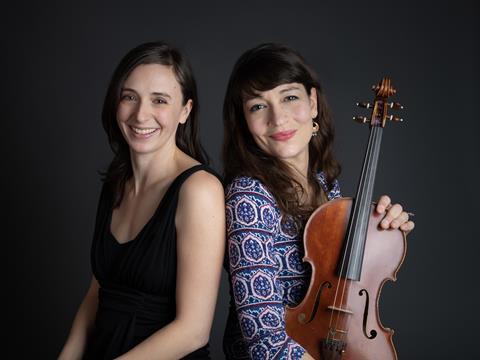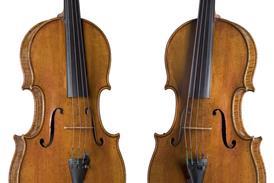Violist Amelia Hollander Ames discusses how her instrument’s unique features can be utilised to great effect in contemporary music

Discover more Featured Stories like this in The Strad Playing Hub
It’s hard to be a violist if you don’t like new music. So much of our repertoire comes from after 1910. Luckily for me, I‘ve always had what my viola professor at Eastman, George Taylor, called ‘an insatiable musical appetite’, in particular for music by friends and colleagues, as well as for improvisation. We violists have to be hungry for a diverse musical feast, to continue George’s metaphor, since we don’t have a huge menu of our own music to order from.
I think that living composers find a less encumbered inspiration in the particular sound of the viola, without a repertoire casting long shadows the way, say, the many violin sonatas of previous composers do. I started out as a violinist, but when I switched to viola in high school, my mum became a big cheerleader for the instrument. ‘It’s the violin of the 21st century!’ she’d declare.
Since the viola has no standardised size, the way violins and cellos do, every instrument has the capacity to produce their own unique sound. And it wasn’t until I started studying improvisation while at the New England Conservatory that I realised just how liberating it was to not have to make a sound that could pass a blind audition to blend into a section of ten other players. The things that make your sound ‘yours’ – grit in the bow, an idiomatic shift, a variety of vibratos – serve wonderfully in an improvised setting, and they are also things a lot of composers I’ve worked with have asked for specifically.
There are various examples of these viola idiosyncrasies in my latest album, Swirl, which also features pianist Elaine Rombola Aveni and with whom we form the RAHA Duo. The album includes six world premieres of works for viola and piano.
Curtis Hughes’ Dept of Levitation Studies, is a great example of writing using traditional techniques, but making incredible use of every part of the viola’s range. The piece tells the story of multiple futile efforts to achieve flight; there are numerous places where big ‘nudges’ initiate from the C string, going all the way up and then evaporating into thin air. There are achingly expressive moments in the high register of the A string that reminded me of Jonny Greenwood talking about his score to Phantom Thread on an interview with NPR. Asked about the very high notes in the solo viola, Greenwood said, ‘You can hear the player, who’s amazing, struggling slightly, and that’s a really nice human emotion to hear in music.’ He could have given the notes to a violinist, but it’s the struggle he wanted, and Curtis captures that as well, in a beautiful way, in his piece.
The piece we named the album after is Marti Epstein’s Swirl for viola, cello (played by Jing Li) and piano. Epstein is actually learning viola herself, and I asked her why. ‘I’m a composer who loves the sound of the viola, and have written many, many, many pieces that include the viola prominently (including a viola duet!). I’m finding (learning the viola) very physically difficult, but I’m finding it very rewarding. When I feel the C string resonating against my body it makes me feel happy,’ she told me. In Swirl, the viola only plays on the C string a few times, but in every case, it is far below both the cello and piano: an unexpected bass line punctuation.
Epstein wrote to me that she appreciated how expressively I played: ‘Too many violists think I intend this piece to be pallid and vibrato-less, which I don’t!’ I wonder if Marti felt this way in the past because we violists spend so much time playing a supporting role in orchestral and chamber music, we often need extra invitations to add expression to notes that might otherwise look simple or unadorned. It’s so important to give every note your fullest expression; even if the score says ‘non vibrato’, there are plenty of ways to give expression using bow placement, speed, and weight.
Emily Koh’s <plithe> for viola and prepared toy piano is full of fascinating extended techniques and viola-specific colours. It starts out on the C string with many microtonal differences that are hard to find, being so close to the resonant note of D, to which it’s so tempting to ‘round up or down.’ In this long opening, one has to listen much more closely to the subtle differences in the half- and quarter-sharps and -flats. Koh goes on to explore all the crazy overtones the viola’s C string can produce via extreme sul ponticello combined with tremolo in both the left and right hands, so by no means is this microtonal opening not resonant! It’s delicious to spend so much time on the C string, even if it is a bit exhausting for the bow arm with the sometimes incredibly slow bow that Koh asks for.
I tell all my students: ‘Befriend the composition majors at your school! They will write you music, and you can help them understand the instrument.’ It’s that soul and power of the viola that inspires me every day, and when you find composers who can tap into it, it’s something really special.
Find more information about Amelia Hollander Ames’s album Swirl here
Read: From Kurtág to Messiaen: a cellist and composer talk contemporary string repertoire
Read: In search of sounds: contemporary violin techniques with Sarah Saviet
Discover more Featured Stories like this in The Strad Playing Hub
The number one source for playing and teaching books, guides, CDs, calendars and back issues of the magazine.
In The Best of Technique you’ll discover the top playing tips of the world’s leading string players and teachers. It’s packed full of exercises for students, plus examples from the standard repertoire to show you how to integrate the technique into your playing.
The Strad’s Masterclass series brings together the finest string players with some of the greatest string works ever written. Always one of our most popular sections, Masterclass has been an invaluable aid to aspiring soloists, chamber musicians and string teachers since the 1990s.
American collector David L. Fulton amassed one of the 20th century’s finest collections of stringed instruments. This year’s calendar pays tribute to some of these priceless treasures, including Yehudi Menuhin’s celebrated ‘Lord Wilton’ Guarneri, the Carlo Bergonzi once played by Fritz Kreisler, and four instruments by Antonio Stradivari.





































1 Readers' comment